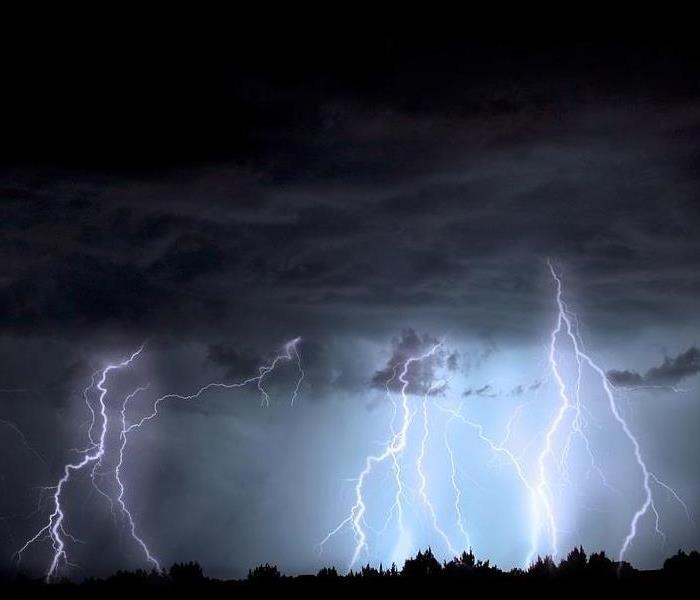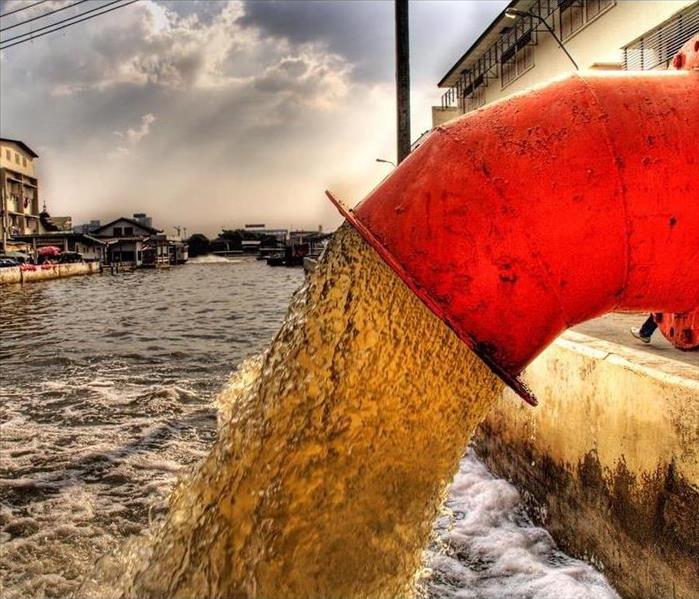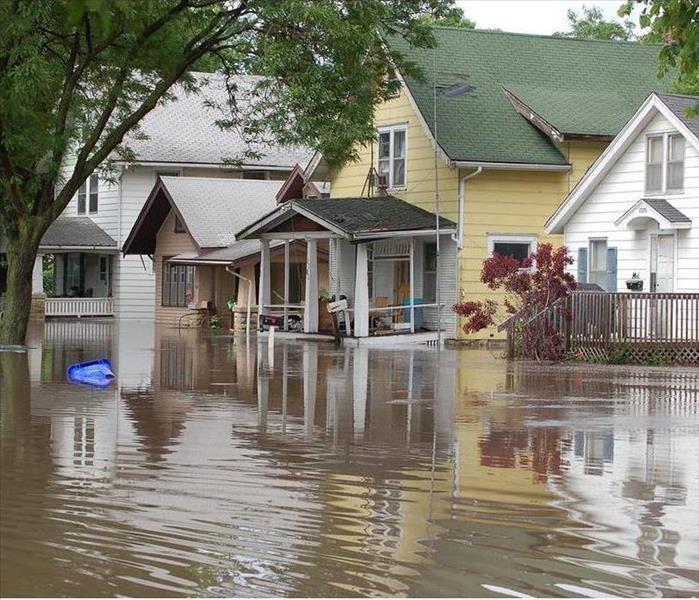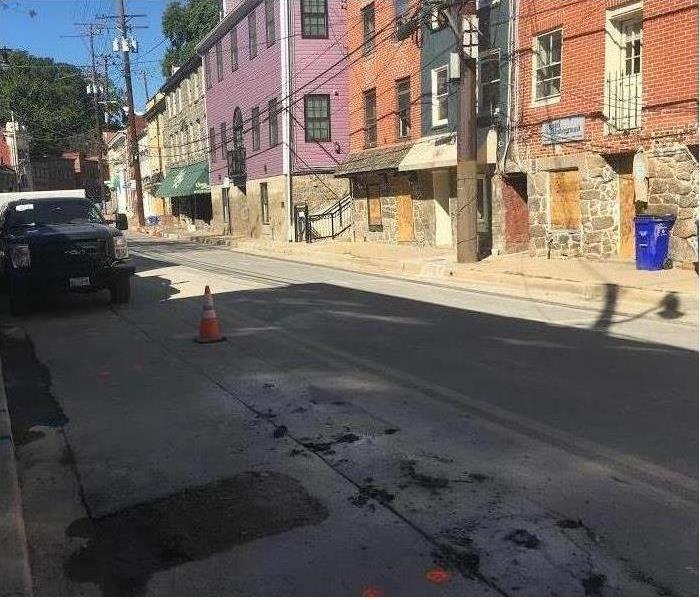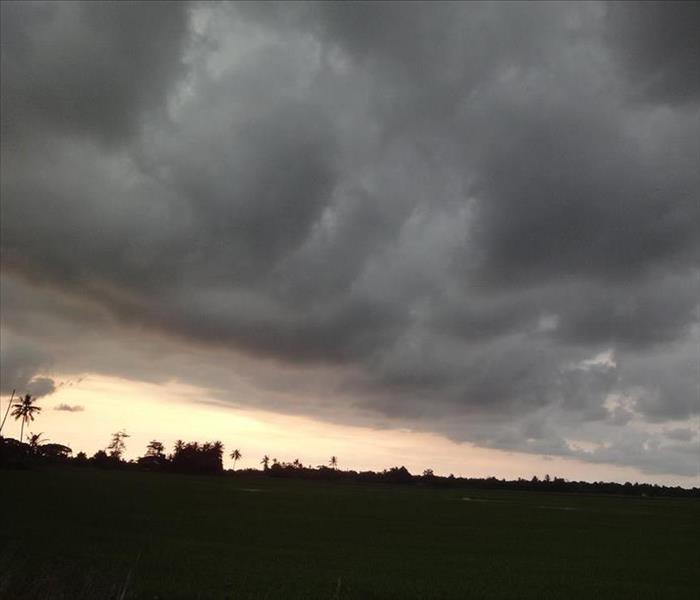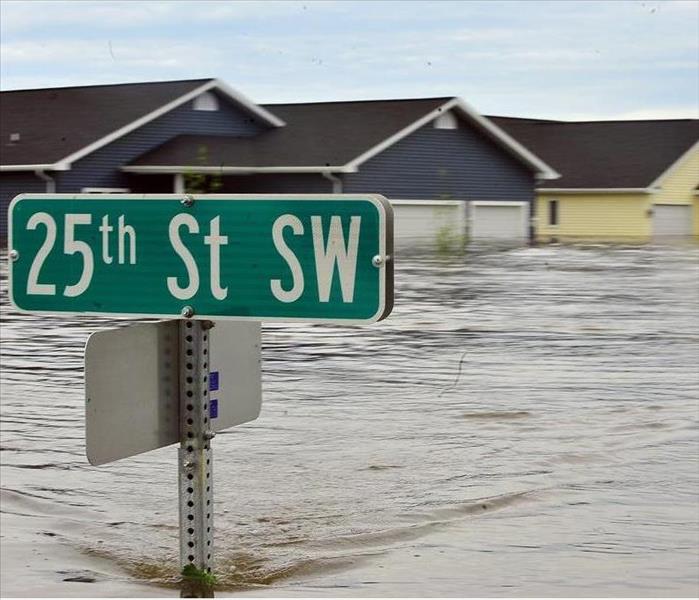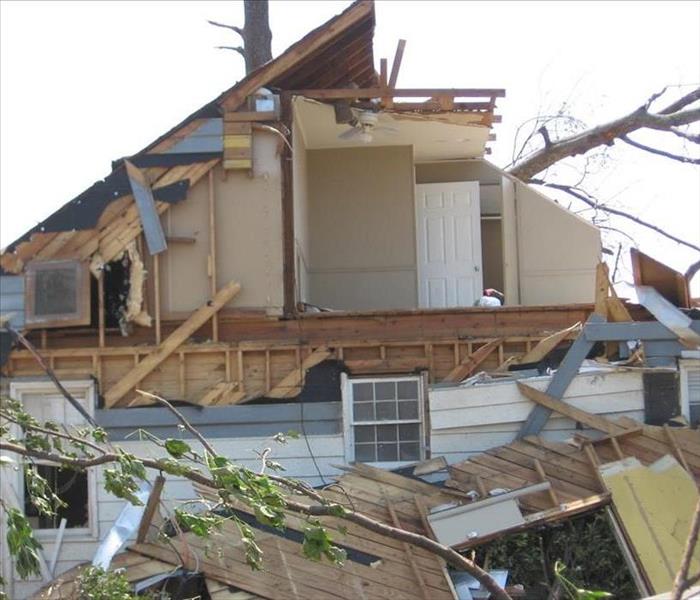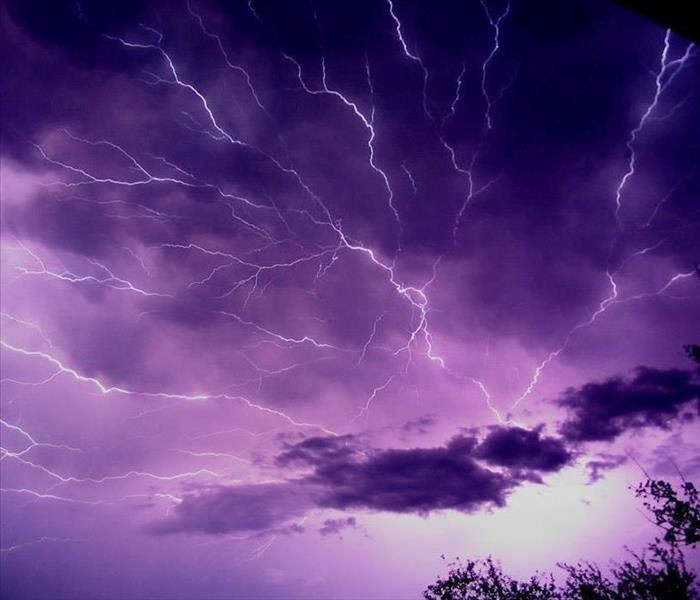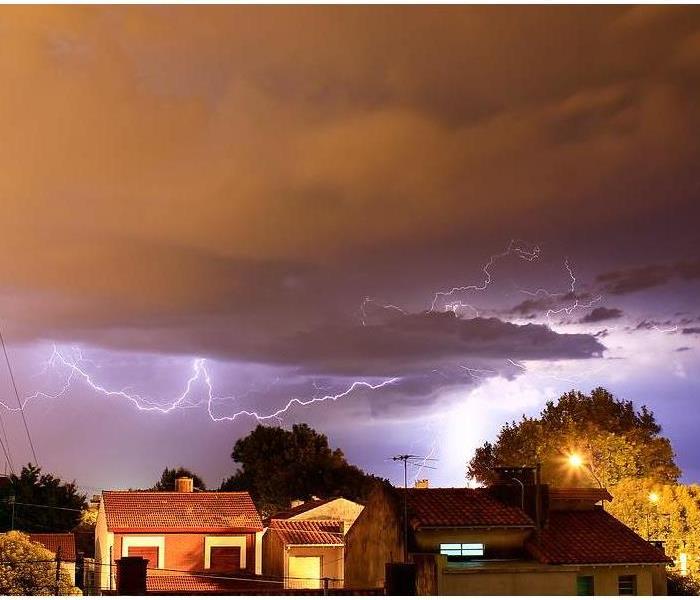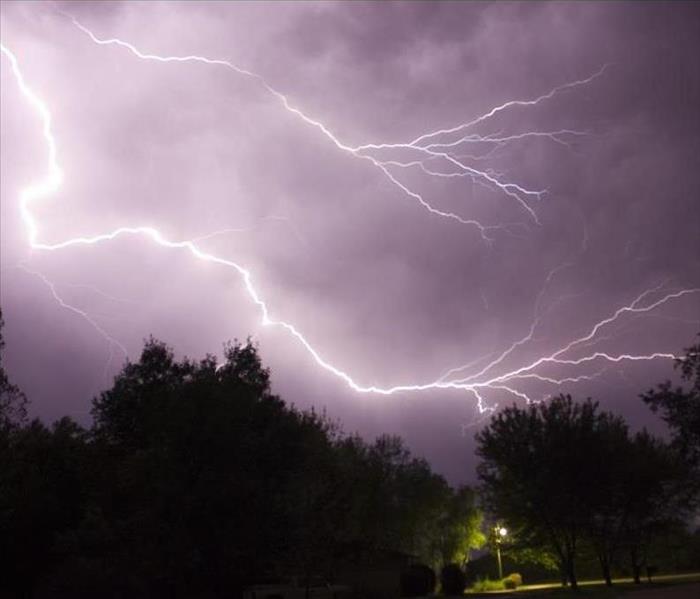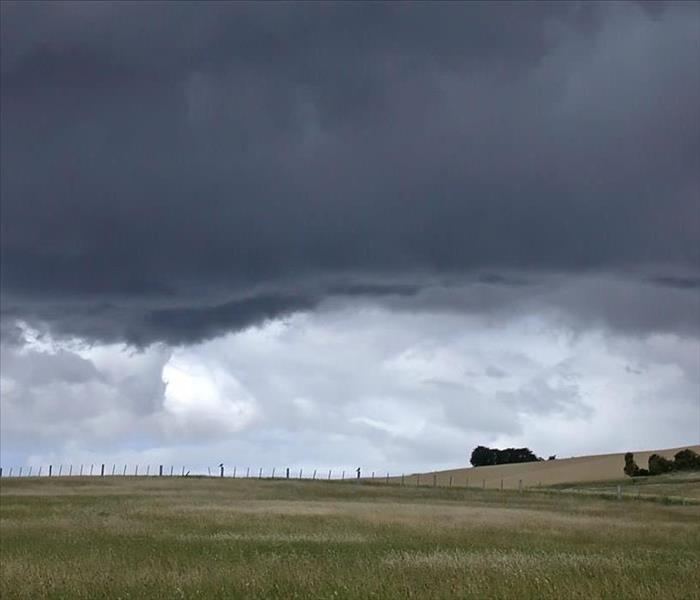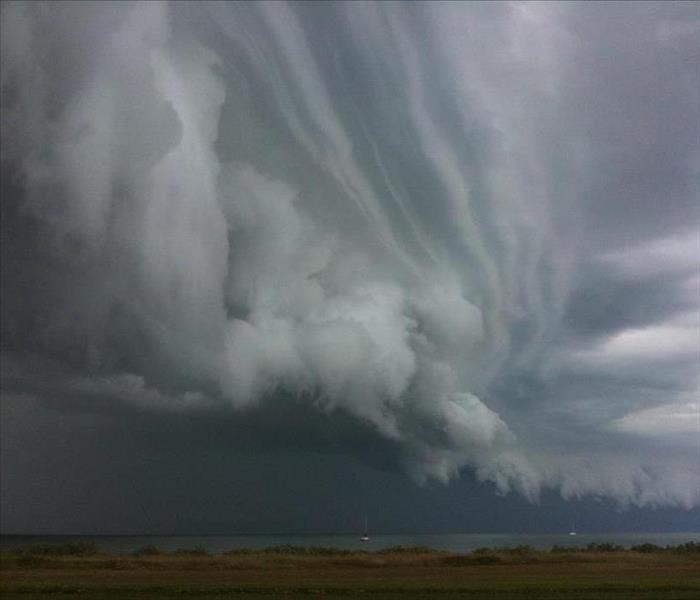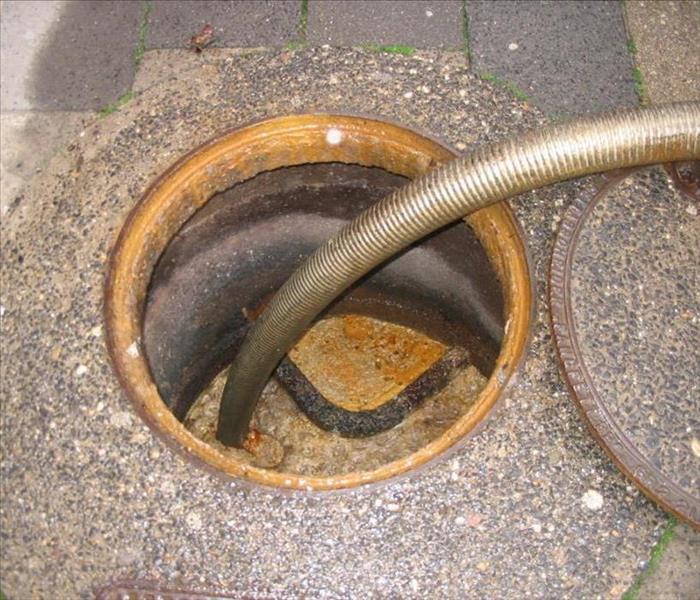Recent Storm Damage Posts
How to Prepare for and Recover from a Severe Storm
8/20/2024 (Permalink)
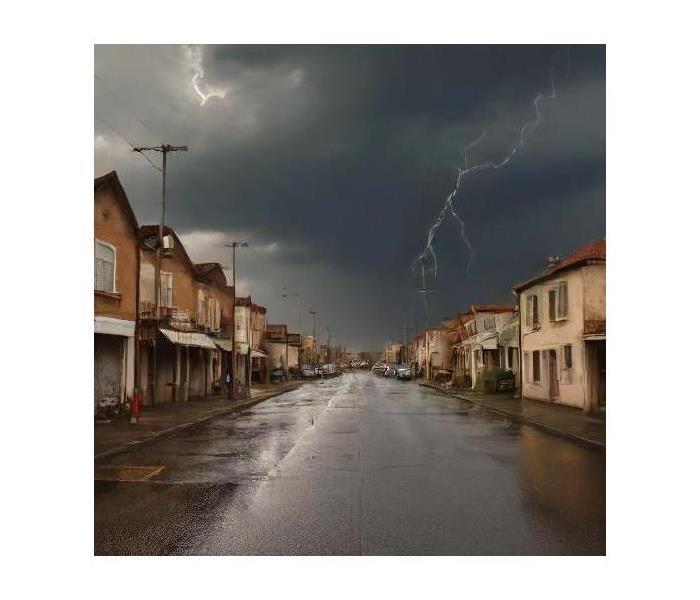 Keep your eyes on stormy skies and keep your indoors dry!
Keep your eyes on stormy skies and keep your indoors dry!
Severe storms can be both frightening and destructive, causing widespread damage and disruption. Whether you’re facing a hurricane, tornado, or severe thunderstorm, knowing how to prepare and respond can make a significant difference. Here’s a comprehensive guide on how to prepare for and recover from a severe storm, helping you stay safe and minimize damage.
Preparing for a Severe Storm
Emergency Kit: Assemble an emergency kit with essential supplies, including non-perishable food, water, medications, a flashlight, batteries, a first aid kit, and important documents. This kit should last at least 72 hours to cover the period when utilities and services might be disrupted.
Home Inspection: Ensure your home is storm-ready by checking for and reinforcing potential vulnerabilities. Secure windows and doors with storm shutters or plywood, and clear gutters and downspouts to prevent water damage.
Communication Plan: Establish a family communication plan, including emergency contact information and meeting points. Ensure all family members know what to do in case of evacuation and how to stay informed through weather alerts and news updates.
Insurance Review: Review your homeowner’s insurance policy to ensure you have adequate coverage for storm damage. Understand the terms of your policy, including coverage limits and deductibles, and make any necessary adjustments.
During the Storm
Seek Shelter: During severe storms, seek shelter in a safe location away from windows and exterior walls. For tornadoes, go to a basement or an interior room on the lowest floor. For hurricanes or severe thunderstorms, stay indoors and avoid using electrical appliances.
Stay Informed: Keep track of weather updates through a battery-powered radio or a weather app. Follow local authorities’ instructions and be prepared to adjust your plans based on the latest information. The Weather Channel offers real-time updates and alerts.
Avoid Flooded Areas: If you encounter floodwaters, avoid driving or walking through them. Just six inches of moving water can knock you off your feet, and it’s impossible to gauge the depth and speed of floodwaters accurately. For flood safety tips, visit the Centers for Disease Control and Prevention (CDC).
Recovering from a Severe Storm
Safety First: Once the storm has passed, ensure it’s safe to leave your shelter. Avoid downed power lines, and check for structural damage before re-entering your home. Use a flashlight rather than candles to avoid fire hazards.
Document Damage: Take photos and videos of any damage to your property for insurance purposes. This documentation will be crucial for filing a claim and assessing the extent of the damage.
Clean Up: Begin clean-up efforts once it’s safe. Remove debris and contaminated items to prevent mold growth and further damage. Use a dehumidifier to dry out affected areas and consider hiring professional restoration services like SERVPRO of Carroll County.
Seek Assistance: If needed, contact local disaster relief organizations or government agencies for assistance. They can provide resources and support for those affected by severe storms, including temporary housing, financial aid, and emergency services.
Being well-prepared and informed can make a significant difference when dealing with severe storms. By following these steps, you can protect yourself, your family, and your property, ensuring a more manageable recovery process after the storm has passed.
Safety Tips During and After a Flood
8/22/2023 (Permalink)
SAFETY FIRST (For businesses and home owners)
- Account that all employees or family members are safe by establishing evacuation plans in advance, identifying areas outside the building that are designated meeting places. Assign select individuals to keep a list of their assigned team’s names and contact numbers in order to account for their whereabouts.
- If water enters the building and evacuation becomes impossible, move to an upper floor, and wait for rescuers.
- While evacuating, avoid attempting to drive through floods or rising water, nearly half of all flash flood fatalities are auto-related.
- Do not touch electrical equipment if you are wet or standing in water.
- Do not walk through moving water. Even six inches of moving water can make you fall.
- Use no open flames (there may be gas escaping from ruptured mains).
- Avoid floodwaters. Water may be contaminated by oil, gasoline or raw sewage. Water may also be electrically charged. If the water has entered the structure through the flooding of a creek, stream or river, or if it has filtered through insulation during its intrusion, it is considered to be black water and could be hazardous to your health. Avoid contact with contaminated items as much as possible.
- Stay out of any building if it is surrounded by floodwaters.
- Listen for news reports to learn if the community’s water supply is safe to drink.
- Return only when authorities indicate it is safe.
SECURE THE PROPERTY
- Contact local emergency officials.
- Secure main entrances to building.
- Alert Security company and Alarm company of the situation.
STABILIZE THE PROPERTY
- Open basement or low-level windows to equalize water pressure on the building’s foundation and walls.
- Begin water damage mitigation steps only if local emergency officials deem the structure safe to enter.
- Notify your insurance agent or Risk Manager to determine insurance policy guidelines and steps to take.
Let's Talk about Sewage Water
9/27/2022 (Permalink)
It's definitely not the most pleasant problem to talk about, but sewage backups or leaks are very real and very serious issues you could face in your home or business.
Earlier we discussed how to tell if the water flooding in your property is clean or contaminated. It's probably the most important to know that sewage water should be assumed to be contaminated and hazardous at all times (until one of our professionals determines otherwise). Sewage water is typically referred to as category 3 black water. This classification is due to the dangerous contaminants in it. It's important to note that sewage water has the ability to appear clean. This is an instance of top water. If sewage runoff looks clean, it's usually because the waste and contaminants have sunk to the bottom. This water is still categorized as black water; not for the color, but for the risk it carries with it. In most cases of any standing water in your home, it's crucial to understand that just because you can't particularly see the contaminants or just because the water looks clear...doesn't mean that it is safe to try to mitigate yourself.
Our SERVPRO of Carroll County crews are specifically trained to deal with hazardous water and how to clean any harmful remnants once the water is drained. Without that training, your knowledge is your most powerful tool to keep you from putting yourself at risk upon spotting standing water in your residential or commercial property.
If you experience sewage backup or sewage related flooding, let us be your first call. We make it, "Like it never even happened."
SERVPRO of Carroll County
410-637-3433
Flooding is Always a Risk
9/15/2022 (Permalink)
Unfortunately, just because you don't reside in a flood zone doesn't means that you won't get flooding.
Even the driest areas can experience what are known as flash floods. Rivers, streams, and lakes are almost always overflowing their banks, given a couple of rainy days. New construction in your neighborhood can even change runoff patterns in the area and can increase our flood risks.
The cost of flood damage is expensive. This cost can vary depending on the type of damage and where the water came from. Any tips that can help prevent this has to be worth the time to try them. You can't stop a flood from damaging your home from the above situations but you can do some things to keep a flood from happening inside your home.
Here are some things to try:
• An inspection and flushing your water heater once a year, by a plumber, can contribute to preventing it bursting on you and flooding the area.
• Replacing the rubber hoses on all appliances that use water with metal braided ones can help to avoid the failing of the rubber ones as they can get hard and burst. Check all hoses; even the metal braided ones every year.
• Leaks from toilets are often indicated by a little leakage from the base.
• Do you know where to locate the main water shut-off? If a pipe burst, inside, you need to be able to get it turned off quickly.
• If you have a sump pump, now is a good time to get it checked and think about a backup unit.
• Always be looking for signs of plumbing leaks, such as on ceilings and walls; you are looking for stains and moisture on those walls and floors.
• Leaking or even broken pipes are often gushing water, and it is not noticed because it might be hidden. Check out your water usage when no faucets are turned on; locate the water meter and take a reading, then use no water for an hour or so and read it again. Has it moved? If so, you have a leak someplace, so get a plumber to check it out.
• Always monitor your monthly water bill. If it goes up a lot one billing cycle, you might have the need for a plumber to come in and check all connections.
• Since a lot of water comes from inside your home and can damage many walls, floors, furniture and provide the moisture needed for molds to grow, doing whatever can be done to prevent leaks is a good exercise to undertake.
Why Board Up?
8/30/2022 (Permalink)
You always see photos of homes and businesses boarding up before or after some kind of damaging event...but do you know why?
In the case of abandoned buildings, boarded up windows and doors are usually a measure to keep vandals or squatters out of the structure. However, in the event of damage or a loss, this process is to protect not only windows and doors from shattering, breaking, or failing in other ways, but to protect the structure itself.
Our professionally trained crews often times board up your home or business before or during mitigation and remediation to prevent any further damage.
If done incorrectly, the boarding up process could actually cause secondary damages such as additional moisture or even animal intrusion.
Whether it's fire, storm, or another kind of structural damage, boarding up can be just as dangerous as it is important. Especially if the damage or loss has already occurred.
The most common reasons to board up your home or business are severe rainstorms, flash flooding, severe thunderstorms, hailstorms, and of course, tornadoes.
While SERVPRO of Carroll County is known to mitigate and remediate fire and water damage, don't forget that we are trained to deal with storm damage as well. Whether it's a tree on your roof, or a flooded basement, we are here to help!
Especially with our rebuild division emerging, SERVPRO of Carroll County should be your first call when it comes to recovering and rebuilding after a major storm event. We make it, "Like it never even happened."
Also be sure to keep up with us on all social media because we will tweet or post to Facebook when our area is at risk for potential storm damage.
Preparing for a Storm
8/22/2022 (Permalink)
We all know in the back of our minds that we should be ready for a disaster. We think we will get to a plan of action, someday. Well, you really need to make it today.
Some steps to help you prepare for an emergency situation.
You should sign up for local alerts/warnings. Download apps but also have wireless emergency alerts.
Design emergency communication plans but also test them in advance.
Assemble emergency supplies. There are many organizations that can help give you a checklist.
Educate yourself and others on local hazards and conduct a drill to practice emergency responses.
Sign up for trainings and classes on preparedness for yourself and even your business employees.
Organize and safeguard critical documents.
Plan with neighbors to help each other and share resources.
Make documents of property and check your insurance to make sure you have relevant coverage. Keep documents at another location if possible.
Keep up your property and make improvements to reduce injury as well as property damage.
You never know when an emergency situation will occur. Make today the day your start to get prepared.
Summer Flooding
8/8/2022 (Permalink)
It's dry, hot conditions outside. Who is thinking about flooding? Not many people.
The fact is that flooding can happen at anytime of the year. After long periods of dry weather, the ground can become hard and not able to absorb water from heavy rain fall.
Try to educate yourself about flood conditions before they happen.
Do you know the difference between a "flood watch" and "flood warning"? A "flood watch" means that a flood is possible in your area. A "flood warning "means flooding is already occurring or will occur soon. You should be prepared to evacuate at a moments notice if needed with a warning.
If there is a flood warning in your area, the smart thing to do is to evacuate and move to higher ground. Stay there until you know it's safe to return.
Don't try to walk through moving water. Even just 6" of water can make you fall down and only 12" can float most cars.
Keep yourself informed and safe when there is a chance of flooding. Remember it can happen anytime of the year.
Is your Home Ready for a Storm?
8/8/2022 (Permalink)
Storms can strike any time anywhere. If a storm struck within the next 15 minutes...would you be prepared? No? Read on.
Approximately 98% of all presidentially declared disasters are related to weather events. These events can lead to about 500 deaths and cause nearly $15 billion in damages, according to the NOAA.
So, how do you make sure you're as ready as possible when severe weather hits? Know your risk and take action.
No matter how high or low your risk level is for severe weather, it's crucial to have an emergency plan and supply kit in place, just in case.
What do you include in your emergency supply kit?
It's important to mix and match these items to suit your specific personal needs, but here are some fundamentals to include:
- Water (1 gallon per person per day)
- Food (non-perishable 3-day supply)
- Manual can opener
- Battery operated radio, preferably and NOAA Weather Radio
- Flashlight and extra batteries
- First aid kit
- Whistle to signal for help, if need be
- Clothing
- Dust masks or bandanas
- Plastic sheeting, garbage bags and duct tape
- Wrench or pliers to turn off utilities, especially during flood or lightning risks
- Hygiene items
- Important documents; copies of insurance policies, identification and bank account info
- Cash
- Fire extinguisher
- Matches in a waterproof container
While this list is suitable for a home or business, if your business needs assistance devising an emergency plan, let us do it for you. We specialize in Emergency Ready Profiles which her minimize damage and business interruption in case of an emergency.
In any event, we are here to help after any type of loss or damage.
Getting Prepared for a Storm
9/27/2021 (Permalink)
Storms can strike any time anywhere. If a storm struck within the next 15 minutes...would you be prepared? Be sure to read on!
Approximately 98% of all presidentially declared disasters are related to weather events. These events can lead to about 500 deaths and cause nearly $15 billion in damages, according to the NOAA.
So, how do you make sure you're as ready as possible when severe weather hits? Know your risk and take action.
No matter how high or low your risk level is for severe weather, it's crucial to have an emergency plan and supply kit in place, just in case.
What do you include in your emergency supply kit?
It's important to mix and match these items to suit your specific personal needs, but here are some fundamentals to include:
- Water (1 gallon per person per day)
- Food (non-perishable 3-day supply)
- Manual can opener
- Battery operated radio, preferably and NOAA Weather Radio
- Flashlight and extra batteries
- First aid kit
- Whistle to signal for help, if need be
- Clothing
- Dust masks or bandanas
- Plastic sheeting, garbage bags and duct tape
- Wrench or pliers to turn off utilities, especially during flood or lightning risks
- Hygiene items
- Important documents; copies of insurance policies, identification and bank account info
- Cash
- Fire extinguisher
- Matches in a waterproof container
While this list is suitable for a home or business, if your business needs assistance devising an emergency plan, let us do it for you. We specialize in Emergency Ready Profiles which her minimize damage and business interruption in case of an emergency.
In any event, we are here to help after any type of loss or damage.
Summer Storms
9/17/2021 (Permalink)
It's dry, hot conditions outside. Who is thinking about flooding? Not many people.
The fact is that flooding can happen at anytime of the year. After long periods of dry weather, the ground can become hard and not able to absorb water from heavy rain fall.
Try to educate yourself about flood conditions before they happen.
Do you know the difference between a "flood watch" and "flood warning"? A "flood watch" means that a flood is possible in your area. A "flood warning "means flooding is already occurring or will occur soon. You should be prepared to evacuate at a moments notice if needed with a warning.
If there is a flood warning in your area, the smart thing to do is to evacuate and move to higher ground. Stay there until you know it's safe to return.
Don't try to walk through moving water. Even just 6" of water can make you fall down and only 12" can float most cars.
Keep yourself informed and safe when there is a chance of flooding. Remember it can happen anytime of the year.
Protecting your Home from Storms
8/25/2021 (Permalink)
One of the most expensive things you will ever own is your home. Keeping up with maintenance is usually easier said than done and can be difficult to plan on at times. Storms are one of many things that can throw a wrench in your plans.
The first thing I always tell my friends is to make sure that their insurance covers all that they think it does. Did you know that water that enters your home from the bottom up (flooding) isn’t covered by homeowners insurance? You can usually get coverage for it but it doesn't come standard usually. For people living on flood plains, adding flood insurance is common practice. Most people don't know that neither flood insurance nor a homeowner’s policy covers sump pump failure though.
Avoid the stress associated with sewer back-ups, seepage issues or flood waters by purchasing targeted pump failure insurance coverage. I've seen people taken by complete surprise that they don't have the coverage that they thought they did.
So one the best things you can do might not be what you thought to protect your house. Having a conversation with your insurance agent is one of the Best. Know what coverage you have and don't have so your not taken by surprise when a storm comes into your life.
Predicting a Disaster
8/23/2021 (Permalink)
Even the Farmer's Almanac can be wrong and miss a storm predication.
Our high tech equipment, can miss a prediction when it comes to the weather as well.
Maybe you're relying on the fact that the experts predicted mild weather, so you're going to pass on getting your roof checked for cracks, or will wait another year before properly insulating your pipes. This could unfortunately end up being a very costly mistake.
The fact is that being prepared for storm damage will benefit you in the long run. Having a well sealed home can save your home from major damage in the future, sometimes the very near future!
If you do get storm damage though it's not recommended to try and do the mitigation yourself.
The experts at SERVPRO of Carroll County have the correct tools and equipment to help save your home when it looks like a total loss. We are the remediation experts and that's a fact, not a prediction!
Predictions vs. Facts
8/10/2021 (Permalink)
Even the Farmer's Almanac can be wrong and miss a storm predication.
Our high tech equipment can miss a prediction when it comes to the weather as well.
Maybe you're relying on the fact that the so-called "experts" predict a mild winter so you're going to pass on getting your roof checked for cracks, or will wait another year before properly insulating your pipes. These could end up being very costly mistakes!
The fact is that being prepared for storm damage will benefit you in the long run. Having a well sealed home can save your home from a tremendous amount of damage.
If you do get storm damage though, it's not recommended to try and do the mitigation yourself.
The experts at SERVPRO of Carroll County have the correct tools and equipment to help save your home when it looks like a total loss. We are the remediation experts, and that's a fact, not a prediction!
Standing Sewage Water
8/10/2021 (Permalink)
It's definitely not the most pleasant problem to talk about, but sewage backups or leaks are very real and very serious issues you could face in your home or business.
It's very important to know that sewage water should be assumed to be contaminated and hazardous at all times (until one of our professionals determines otherwise). Sewage water is typically referred to as category 3 black water. This classification is due to the dangerous contaminants in it. It's important to note that sewage water has the ability to appear clean. This is an instance of top water. If sewage runoff looks clean, it's usually because the waste and contaminants have sunk to the bottom. This water is still categorized as black water; not for the color, but for the risk it carries with it. In most cases of any standing water in your home, it's crucial to understand that just because you can't particularly see the contaminants or just because the water looks clear, doesn't mean that it is safe to try to mitigate yourself.
Our SERVPRO of Carroll County crews are specifically trained on dealing with hazardous water and how to clean any harmful remnants once the water is drained. Without that training, your knowledge is your most powerful tool to keep you from putting yourself at risk upon spotting standing water in your residential or commercial property.
If you experience sewage backup or sewage related flooding, let us be your first call. We make it, "Like it never even happened."
What is an Ice Dam?
9/30/2020 (Permalink)
Correct ventilation in an attic is key to avoiding ice dams in your home. Without proper ventilation in the attic, heat will rise through the roof peak, making the center of the roof warmer than the edges. After a snowstorm, this uneven spread in temperature causes the snow to melt at different rates. Ice then builds near the edges and blocks snow-melt from draining through the gutter system. This process is called ice damming. As the snow melts, water can dislodge the shingles and roof flashing and even pry apart gutter seams. Because water expands when it freezes, the cycle of freezing and thawing can magnify this damage. If ice dams form on your gutters, water can eventually permeate the roof and cause wood-rot, mold, and drywall damage in your attic. For restoration services please call SERVPRO of Carroll County 410-857-5332
Flood Zone
9/21/2020 (Permalink)
Floods rank as one of the most common and widespread natural disasters in the United States. Whether you live near the coastline, along city streets or near a river or lake, there is always a potential for suffering flood damage. On average, floods cost $6 billion in annual losses in the U.S. Flooding can also result from plumbing failures, frozen pipes and damaged structures. Flood damage can affect your business operation in a variety of ways and can range in size from being isolated to a single room to entire floors being fully submerged.
Knowing how to prepare and deal with potential flooding in advance can affect how much of your property can be restored and how much has to be replaced. Below are prevention, mitigation and restoration tips to follow until help arrives:
Flood Prevention Tips:
- Determine if your property is in a floodplain.
- In any emergency, always listen to the instructions given by local emergency management officials.
- Carefully assess how your company functions, both internally and externally, to determine which staff, materials, procedures and equipment are absolutely necessary to keep the business operating.
- Plan what you will do if your building, plant or store is not accessible. This type of planning is often referred to as a continuity of operations plan, or COOP, and includes all facets of your business.
- Plan for payroll continuity.
- Review your emergency plans annually. Just as your business changes over time, so do your preparedness needs. When you hire new employees or when there are changes in how your company functions, you should update your plans and inform your people.
After storm safety check list
8/28/2020 (Permalink)
- Make contact with family and friends in the affected area and let those that you know outside of the affected area that you are safe.
- Return home only when authorities indicate it is safe. Attempting to re-enter the area can be dangerous and it is important to wait until the area has been cleared as safe by officials.
- Avoid areas with debris and downed power lines.
- Avoid flood waters, whether on foot or in vehicle. Just 6 inches of moving water can knock a person down, and one foot of fast-moving water can sweep your vehicle away.
- Take note of any damage to your belongings or to your property
- Photograph any damage to your belongings/property for insurance purposes
- Tarp or board up damaged roofs and windows to prevent further damage. Your insurance may not cover additional damage that occurs after the storm has passed.
Lightning
8/26/2020 (Permalink)
What You Need to Know, NO PLACE outside is safe when thunderstorms are in the area. If you hear thunder, lightning is close enough to strike you. When you hear thunder, immediately move to safe shelter: a substantial building with electricity or plumbing or an enclosed, metal-topped vehicle with windows up. Stay in safe shelter at least 30 minutes after you hear the last sound of thunder.
Stay off corded phones, computers and other electrical equipment that put you in direct contact with electricity. Avoid plumbing, including sinks, baths and faucets. Stay away from windows and doors, and stay off porches. Do not lie on concrete floors, and do not lean against concrete walls.
SERVPRO of Carroll County is here to help if you experience damage to your home or business from lightening. Lightening is very powerful and can cause odor, damaged structure, or even a fire. We are here to help you clean it up. 410-857-5332
Don't drown, turn around!
8/13/2020 (Permalink)
Most of the flood related deaths occur in cars, because the driver didn’t realize the depth of the floodwater. However, even a little bit of standing water on a road can cause a big-time problem. Here's what can happen at specific water depths:
• 6 inches: Water up to 6 inches deep can cause your tires to lose traction with the road. When this happens, your vehicle can skid. While you probably won't drown in this situation, losing control of the vehicle may cause you to crash.
• 12 inches: A foot of water can cause small and midsize vehicles to float. If the water is moving fast, your car can be carried away by the current—with you still inside.
• 24 inches: Even large pickups and SUVs can be swept away by 2 feet of water on a flooded street. Worse yet, as the vehicle is carried along, it may tip over, trapping you inside with the floodwater still rising.
Your emergency check list
8/13/2020 (Permalink)
- Water (one gallon per person per day)
- Food (non-perishable 3-day supply)
- Dust masks or bandanas
- Battery operated radio, preferably a NOAA Weather Radio
- Flashlight and extra batteries
- Fire extinguisher
- Whistle to signal for help
- Clothing
- Manual can opener
- Plastic sheeting, garbage bags and duct tape
- Wrench or pliers to turn off utilities
- Hygiene items
- Important documents; copies of insurance policies, identification and bank account information
- Cash
- first aid kit
- Matches in a waterproof container
SERVPRO of Carroll County is locally owned and operated, so we’re a part of this community too. We are also part of a national network of over 1,700 Franchises, which enables us to respond quicker with more resources. For major storms and disasters, we can call upon special Disaster Recovery Teams strategically located throughout the country.
Lightning
7/1/2019 (Permalink)
 Chimney hit by lightning
Chimney hit by lightning
SERVPRO of Carroll County is here to help if you experience damage to your home or business from lightening. Lightening is very powerful and can cause odor, damaged structure, or even a fire. We are here to help you clean it up. 410-857-5332
Lightning
What You Need to Know, NO PLACE outside is safe when thunderstorms are in the area!! If you hear thunder, lightning is close enough to strike you. When you hear thunder, immediately move to safe shelter: a substantial building with electricity or plumbing or an enclosed, metal-topped vehicle with windows up. Stay in safe shelter at least 30 minutes after you hear the last sound of thunder.
Stay off corded phones, computers and other electrical equipment that put you in direct contact with electricity. Avoid plumbing, including sinks, baths and faucets. Stay away from windows and doors, and stay off porches. Do not lie on concrete floors, and do not lean against concrete walls.
Preparing your Pets for Emergencies
5/10/2019 (Permalink)
Remember, during a disaster what’s good for you is good for your pet, so get them ready today. If you leave your pets behind, they may be lost, injured or worse. Never leave a pet chained outdoors. Plan options include: Create a buddy system in case you’re not home. Ask a trusted neighbor to check on your animals. Identify shelters. For public health reasons, many emergency shelters cannot accept pets. Find pet friendly hotels along your evacuation route and keep a list in your pet’s emergency kit. Locate boarding facilities or animal hospitals near your evacuation shelter. Consider an out-of-town friend or relative. Locate a veterinarian or animal hospital in the area where you may be seeking temporary shelter in case your pet needs medical care. Add the contact information to your emergency kit. Have your pet micro chipped and make sure that you not only keep your address and phone number up-to-date, but that you also include contact info for an emergency contact outside of your immediate area. Call your local emergency management office, animal shelter or animal control office to get advice and information. If you are unable to return to your home right away, you may need to board your pet. Find out where pet boarding facilities are located. Most boarding kennels, veterinarians and animal shelters will need your pet's medical records to make sure all vaccinations are current. If you have no alternative but to leave your pet at home, there are some precautions you must take, but remember that leaving your pet at home alone can place your animal in great danger!
Prepare Your Home for an Emergency
5/10/2019 (Permalink)
Planning for any emergency requires considering all likely scenarios that could result when things that you rely on daily- such as electricity, water, heat, air conditioning, telephone services and transportation- are disrupted or lost for a considerable amount of time. Consequently, you should plan on having food, water, and other essential goods to get you through the emergency. Most emergency management planner suggests having enough supplies to last you and your family for three to five days for weather -related events. However, many things may affect you decision, including storage space, special needs, number of people I the household and available resources.
The basic items that should be stored in your home include water, food, first aid supplies, clothing and bedding, tools, emergency supplies, and specialty items. Keep the items that you would most likely need at home in one easy-to-carry container such as a plastic storage bin, backpack, or duffel bag. Store it in a convenient place and put a smaller version in your car. Remember to change the stored water and rotate the food supplies every six months (place dates on the containers). Check the supplies and re-evaluate your needs every year. Consult your physician or pharmacist about storing medications, and maintain a current list of your family’s prescription needs.
Tornado Safety
5/10/2019 (Permalink)
Tornado Safety - what YOU Can Do!
Before the Storm:
- Develop a plan for you and your family for home, work, school, and when outdoors.
- Have frequent drills
- Know the county in which you live, and keep a highway map nearby to follow storm movements from weather bulletins.
- Have a NOAA All Hazards Weather Radio with a warning alarm tone and batter back-up to receive warnings.
- Listen to radio and television for information
- If planning a trip outdoors, listen to the latest forecasts and take necessary action if threatening weather is possible.
If a Tornado Warning is issued or if threatening weather approaches
- In a home or building, move to a pre-designated shelter, such as a basement.
- If an underground shelter is not available, more to an interior room or hallway on the lowest floor and get under a sturdy piece of furniture.
- Stay away from windows
- Do not try to out run a tornado in your car: get out of your car immediately and seek nearby safe shelter in a sturdy building.
- Mobile homes, even if tied down, offer little protection from tornadoes and should be abandoned.
- If in open country and no shelter is available, lie flat and face down on low ground protecting the back of your head with your arms. Get as far away as possible from trees and cars, as they can be blown onto you.
Storm Damage
2/28/2019 (Permalink)
FLOOD TIPS AND ACTION STEPS
AFTER A FLOOD
SAFETY FIRST (For businesses and home owners)
- Account that all employees or family members are safe by establishing evacuation plans in advance, identifying areas outside the building that are designated meeting places. Assign select individuals to keep a list of their assigned team’s names and contact numbers in order to account for their whereabouts.
- If water enters the building and evacuation becomes impossible, move to an upper floor, and wait for rescuers.
- While evacuating, avoid attempting to drive through floods or rising water, nearly half of all flash flood fatalities are auto-related.
- Do not touch electrical equipment if you are wet or standing in water.
- Do not walk through moving water. Even six inches of moving water can make you fall.
- Use no open flames (there may be gas escaping from ruptured mains).
- Avoid floodwaters. Water may be contaminated by oil, gasoline or raw sewage. Water may also be electrically charged. If the water has entered the structure through the flooding of a creek, stream or river, or if it has filtered through insulation during its intrusion, it is considered to be black water and could be hazardous to your health. Avoid contact with contaminated items as much as possible.
- Stay out of any building if it is surrounded by floodwaters.
- Listen for news reports to learn if the community’s water supply is safe to drink.
- Return only when authorities indicate it is safe.
SECURE THE PROPERTY
- Contact local emergency officials.
- Secure main entrances to building.
- Alert Security company and Alarm company of the situation.
STABILIZE THE PROPERTY
- Open basement or low-level windows to equalize water pressure on the building’s foundation and walls.
- Begin water damage mitigation steps only if local emergency officials deem the structure safe to enter.
- Notify your insurance agent or Risk Manager to determine insurance policy guidelines and steps to take.





 24/7 Emergency Service
24/7 Emergency Service

